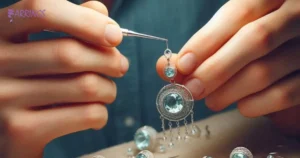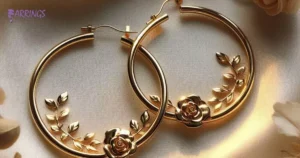The recommended time to wait before changing new earrings is typically 6 weeks to 3 months. This allows enough time for the pierced hole to fully heal and stabilize. Changing earrings too soon risks irritating the piercing, which can cause infections, bleeding, and damage.
Got a new piercing but are impatient to swap out earrings? Before you ask how long until I can change my earrings? read this. Learn why waiting for the recommended 6 weeks to 3 months before changing jewelry is key for fully healed, problem-free piercings.
Waiting to change new earrings protects piercings. Keep reading to learn why following the 6-week to 3-month guideline is key for healed, problem-free piercings. Get tips to properly care for and stabilize fresh holes.
Key Takeaways
- Changing earrings is a gradual process linked to proper healing.
- Patience is crucial, with a recommended healing time of 6-8 weeks.
- Monitor your body for signs of recovery, such as the absence of redness or discomfort.
- When your body signals readiness, enjoy expressing your unique style through new earrings.
- Remember, self-care and self-expression are intertwined in this earring journey.
What Are Ear Piercings?
Ear piercings are small holes in your earlobe or cartilage. People get them for various reasons, like tradition, style, or self-expression. The process involves a sharp needle or a piercing gun, and it’s usually quick and not too painful. Afterward, you need to care for the pierced area to prevent infection and promote healing.
There are different types of ear piercings, like the classic lobe piercing or more adventurous helix and tragus piercings. The healing time varies, but it’s crucial to keep the pierced area clean and avoid touching it unnecessarily. Whether it’s a single stud or an intricate arrangement, ear piercings have been a form of personal adornment for centuries, making a statement about individuality and cultural significance.
What to Do Immediately After Getting Your Ears Pierced?
After getting your ears pierced, 14K solid gold cartilage hoop wearers should start by cleaning them twice a day using a saline solution. Avoid touching your earrings with dirty hands to prevent infections. Keep hair products away from your new piercings to prevent irritation. Stick to the cleaning routine until your ears heal completely.
Remember not to twist or turn the earrings during the healing process. Wear loose-fitting clothing to avoid any unnecessary friction. Avoid swimming in pools or hot tubs during the initial healing period. Stay patient, follow these steps, and enjoy your new ear piercings hassle-free.
How Long Do You Have to Wait Before Changing Earrings?

When switching earrings, it’s crucial to wait until your piercings have fully healed. Rushing this process may lead to irritation or infections. Generally, allow at least six weeks for lobes and 12 weeks for cartilage. Patience ensures a smooth transition and reduces the risk of complications.
After the initial waiting period, remember to clean both earrings and earlobes regularly. This practice maintains hygiene and prevents infections. Use a gentle solution like saline water and avoid harsh chemicals. Keeping your earrings and ears clean is a simple yet essential step in caring for your piercings.
Type of Earrings to Wear After Your Piercings Have Healed
| Earring Type | Description |
| Studs | Classic, low-profile; great for everyday wear. |
| Hoops | Adds a touch of glamour; versatile for various looks. |
| Cuffs | Edgy and stylish; wraps around the ear without a post. |
| Huggies | Small hoops that hug the earlobe; trendy and subtle. |
| Threader Earrings | Delicate and unique; threads through the piercing. |
Once your piercings heal, opt for lightweight studs or hoops. Heavy earrings may stretch or irritate your earlobes, slowing down the healing process. Stick to smaller designs to avoid unnecessary discomfort.
Consider hypoallergenic materials like gold or titanium for your earrings. These metals are less likely to cause irritation or infection. Remember, proper care and choosing suitable earrings ensure a comfortable and stylish post-piercing experience.
Some Tips for Taking Care of Your New Piercings
Firstly, keep it clean. Gently clean your new piercing with mild soap and water twice a day. Avoid harsh chemicals or alcohol-based solutions, as they can irritate the piercing.
Secondly, hands-off policy. Resist the urge to touch or twist the jewelry. Let it be, and avoid unnecessary movement that can disrupt the healing process.
Additionally, watch the water. Be cautious with swimming in pools, hot tubs, or natural bodies of water during the initial healing period. They may introduce bacteria that can lead to infection.
Lastly, be mindful of clothing choices. Opt for loose-fitting, breathable fabrics to prevent irritation. Avoid tight or restrictive clothing that may rub against the piercing, hindering the healing progress.
Different Types of Piercings You Can Get on Your Ears

Earlobe piercings are the most common. Many start here:
- Simple and quick
- Suitable for all ages
- Choose various earrings
Cartilage piercings are a bit edgier:
- Higher on the ear
- Trendy and stylish
- Requires more care
What to Do If Your Piercings Get Infected?
If your piercing gets infected, act promptly. Clean it with saline solution twice daily; avoid alcohol or hydrogen peroxide, as they can irritate. Keep the piercing dry after cleaning; moisture can worsen the infection. If redness, swelling, or pus persists, consult a professional.
Seek medical attention if the infection worsens. Hot compresses can help reduce swelling. Don’t remove the jewelry, it can trap the infection. Maintain good hygiene; wash hands before touching the piercing. Stay mindful of any signs of allergy or adverse reactions. A timely response ensures a smoother healing process.
Where Should I Get Ear Piercings Done?
Choosing where to get your ear piercings done is crucial for a pain-free and enjoyable experience. Start by researching local piercing studios or reputable jewelry stores. Look for places that prioritize hygiene and use sterilized equipment to ensure a safe and clean piercing process.
Consider seeking recommendations from friends or family members who have had positive experiences. It’s also a good idea to read online reviews to get insights from others who’ve been pierced at a particular establishment. Remember, a well-established and professional piercing studio can make all the difference in ensuring your ear piercing is done with precision and care.
How Can I Style My Ear Piercings?

Deciding on the right style for your ear piercings is fun and personal. Start by choosing a variety of earrings that reflect your vibe. Mix and match studs, hoops, and cuffs for a stylish combo. Keep it simple or go bold, make it yours!
Consider the placement of your piercings when styling. Play with asymmetry or create a balanced look. Cartilage piercings can handle a snug fit, while lobe piercings offer versatility. Experiment with different shapes and sizes to find what complements your features. Express yourself through your ear game.
Frequently Asked Questions
Can you change earrings after 2 weeks?
Yes, after two weeks, changing earrings is generally safe if your piercings are healing well. Ensure proper hygiene and use gentle, hypoallergenic earrings during the initial stages.
Can I take my earrings out after 4 weeks?
Yes, after 4 weeks, it’s generally safe to remove your earrings, but ensure you follow proper aftercare to avoid complications. Always consult with your piercer for personalized advice.
How do I know if my ear piercing is healed?
When your ear piercing is healed, it should no longer be red, swollen, or painful. Look for the absence of discharge, and ensure the pierced area feels comfortable and doesn’t show signs of irritation.
Conclusion
In conclusion, styling your ear piercings is a unique journey. Whether you prefer a subtle or bold look, the key is personal expression. Experiment with different earring types, and find what resonates with your style.
Now, regarding the burning question, How long until I can change my earrings? Patience is crucial. Allow at least 6-8 weeks for healing. Rushing can lead to complications. Listen to your body; when it feels right, switch it up. Remember, self-expression is a gradual process.











